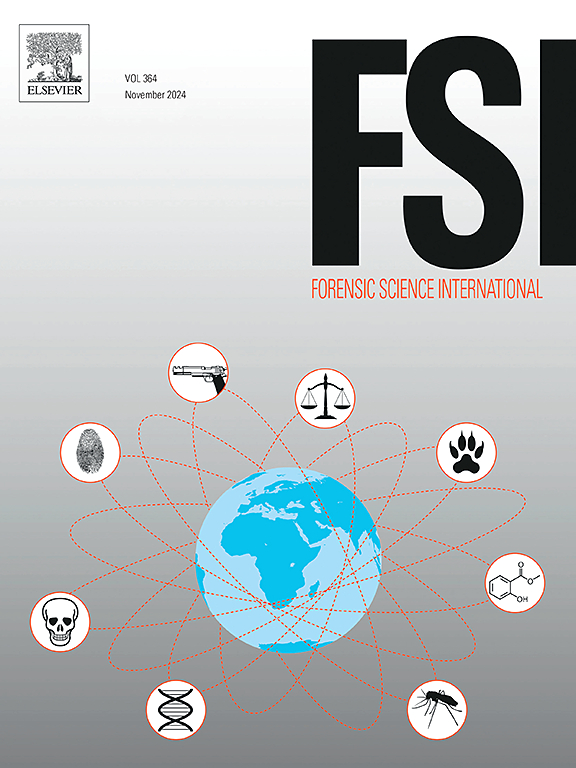Inhalation and oral administration of HHC products – Quantification of (9R)-, (9S)-Hexahydrocannabinol and metabolites in plasma and detectability in on-site drug tests for urine and oral fluid
IF 2.2
3区 医学
Q1 MEDICINE, LEGAL
引用次数: 0
Abstract
The semisynthetic cannabinoid Hexahydrocannabinol (HHC) has gained recognition among drug users. A GC-MS/MS method for the detection of (9R)- and (9S)-HHC and their respective carboxy- and hydroxy-metabolites in plasma has been developed and validated. The method was applied to authentic plasma samples obtained from a self-administration experiment. HHC was either inhaled (Vapes, 95 % HHC) or ingested (Jellys, 25 mg HHC). Maximum plasma (9R)-HHC and (9S)-HHC concentrations of 3.8 ng/mL and 2.5 ng/mL were detected 1.16 h after ingestion and approx. 65 ng/mL (9R)-HHC and 21 ng/mL (9S)-HHC were measured 0.08 h after inhalation. (9 R)-OH-HHC concentrations ranged from approx. 0.3–1.4 ng/mL after ingestion, and approx. 0.2–1.8 ng/mL after inhalation. (9R)-COOH-HHC was detectable in concentrations of 0.8–17 ng/mL (ingestion) and 0.6–8.7 ng/mL (inhalation). Corresponding S-Hydroxy- and Carboxy-metabolites were detectable after ingestion ((9S)-OH-HHC: approx. 0.1–0.7 ng/mL, (9S)-COOH-HHC: approx. 0.2–0.4 ng/mL), but mainly not after inhalation. Cannabimimetic effects and respective psychomotor impairments such as (slight) vertigo as well as slight headache and dizziness, and mouth dryness could be observed after ingestion. After inhalation, one participant showed distinct impairments. On-site drug tests for cannabinoids in urine (DrugScreen®) and oral fluid (DrugWipe® 5S) were performed. DrugScreen® (cut-off: 25 ng/mL THC-COOH) gave positive results up to 10 h after ingestion and inhalation. Cross-reactivity with DrugWipe® 5S (cut-off: 5 ng/mL THC) was not observed. An immunological CEDIA™ cannabinoid assay showed good cross-reactivity with the plasma samples and gave positive results up to 6.16 h after ingestion and 4.16 h after inhalation.
半合成大麻素六氢大麻酚(HHC)已得到吸毒者的认可。我们开发并验证了一种 GC-MS/MS 方法,用于检测血浆中的 (9R)- 和 (9S)-HHC 及其各自的羧基和羟基代谢物。该方法适用于通过自我给药实验获得的真实血浆样本。吸入(Vapes,95% HHC)或摄入(果冻,25 毫克 HHC)HHC。摄入 1.16 小时后检测到的血浆 (9R)-HHC 和 (9S)-HHC 最高浓度分别为 3.8 纳克/毫升和 2.5 纳克/毫升,吸入 0.08 小时后检测到的血浆 (9R)-HHC 和 (9S)-HHC 最高浓度分别为 65 纳克/毫升和 21 纳克/毫升。摄入后,(9R)-OH-HHC 的浓度范围约为 0.3-1.4 纳克/毫升,吸入后约为 0.2-1.8 纳克/毫升。(9R)-COOH-HHC 的检测浓度为 0.8-17 纳克/毫升(摄入)和 0.6-8.7 纳克/毫升(吸入)。摄入后可检测到相应的 S-羟基和羧基代谢物((9S)-OH-HHC:约 0.1-0.7 纳克/毫升,(9S)-COOH-HHC:约 0.2-0.4 纳克/毫升),但吸入后主要检测不到。摄入后可观察到大麻拟效作用和相应的精神运动障碍,如(轻微)眩晕、轻微头痛和头晕以及口干。一名学员在吸入后出现了明显的障碍。现场进行了尿液(DrugScreen®)和口服液(DrugWipe® 5S)中大麻素的药物检测。DrugScreen®(临界值:25 纳克/毫升 THC-COOH)在摄入和吸入后 10 小时内均呈阳性结果。与 DrugWipe® 5S(临界值:5 纳克/毫升 THC)未发现交叉反应。免疫学 CEDIA™ 大麻测定显示与血浆样本有很好的交叉反应,在摄入后 6.16 小时和吸入后 4.16 小时内均呈阳性结果。
本文章由计算机程序翻译,如有差异,请以英文原文为准。
求助全文
约1分钟内获得全文
求助全文
来源期刊

Forensic science international
医学-医学:法
CiteScore
5.00
自引率
9.10%
发文量
285
审稿时长
49 days
期刊介绍:
Forensic Science International is the flagship journal in the prestigious Forensic Science International family, publishing the most innovative, cutting-edge, and influential contributions across the forensic sciences. Fields include: forensic pathology and histochemistry, chemistry, biochemistry and toxicology, biology, serology, odontology, psychiatry, anthropology, digital forensics, the physical sciences, firearms, and document examination, as well as investigations of value to public health in its broadest sense, and the important marginal area where science and medicine interact with the law.
The journal publishes:
Case Reports
Commentaries
Letters to the Editor
Original Research Papers (Regular Papers)
Rapid Communications
Review Articles
Technical Notes.
 求助内容:
求助内容: 应助结果提醒方式:
应助结果提醒方式:


